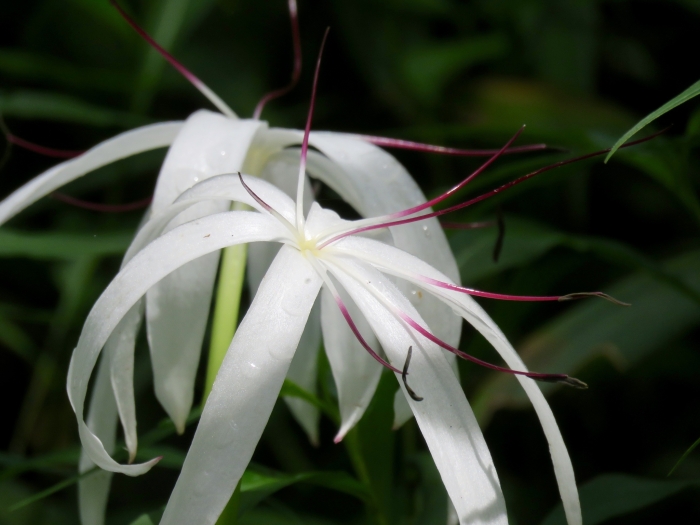Florida Swamp-Lily
(Crinum americanum)
Florida Swamp-Lily (Crinum americanum)
/
/

Laura Clark
CC BY 4.0
Image By:
Laura Clark
Recorded By:
Copyright:
CC BY 4.0
Copyright Notice:
Photo by: Laura Clark | License Type: CC BY 4.0 | License URL: http://creativecommons.org/licenses/by/4.0/ | Rights Holder: Laura Clark | Publisher: iNaturalist | Date Created: 2017-08-11T11:58:42-07:00 |
























































Estimated Native Range
Summary
Crinum americanum, commonly known as Florida Swamp-Lily, is a perennial herb that can be evergreen or deciduous depending on the climate. It is native to wetlands such as marshes, swamps, and the edges of ponds and streams in the Southeastern United States, extending into Mexico and the Caribbean. This plant typically grows to a height of 2-3 feet (0.6-0.9 meters) and a width of 1-2 feet (0.3-0.6 meters). The Florida Swamp-Lily has strap-shaped leaves and produces showy, fragrant flowers that are white with a pink or rose blush, blooming in the summer and fall. The flowers are borne on tall stalks and are quite attractive to pollinators.
The Florida Swamp-Lily is valued for its striking flowers and ability to thrive in wet conditions, making it a popular choice for water gardens, rain gardens, and naturalized areas. It is also used in borders for its lush foliage and fragrant blooms. In cultivation, it requires full sun to part shade and prefers high moisture levels, often growing well in aquatic environments. The soil should be consistently moist to wet, with slow or standing drainage. While generally low maintenance, it can be susceptible to spider mites and bulb rot if conditions are too dry. It is not known to have aggressive roots or significant disease problems. Gardeners should be aware that all parts of the plant are toxic if ingested.CC BY-SA 4.0
The Florida Swamp-Lily is valued for its striking flowers and ability to thrive in wet conditions, making it a popular choice for water gardens, rain gardens, and naturalized areas. It is also used in borders for its lush foliage and fragrant blooms. In cultivation, it requires full sun to part shade and prefers high moisture levels, often growing well in aquatic environments. The soil should be consistently moist to wet, with slow or standing drainage. While generally low maintenance, it can be susceptible to spider mites and bulb rot if conditions are too dry. It is not known to have aggressive roots or significant disease problems. Gardeners should be aware that all parts of the plant are toxic if ingested.CC BY-SA 4.0
Plant Description
- Plant Type: Herb
- Height: 2-3 feet
- Width: 1-2 feet
- Growth Rate: Moderate
- Flower Color: White
- Flowering Season: Summer, Fall
- Leaf Retention: Semi-deciduous
Growth Requirements
- Sun: Full Sun, Part Shade
- Water: High, Aquatic
- Drainage: Slow, Standing
Common Uses
Bee Garden, Bird Garden, Butterfly Garden, Fragrant, Potted Plant, Showy Flowers, Water Garden
Natural Habitat
Native to wetlands such as marshes, swamps, and the edges of ponds and streams in the Southeastern United States, Mexico, and the Caribbean
Other Names
Common Names: Seven Sisters, String Lily, Southern Swamp Crinum, String-Lily, Amerikansk Krinum
Scientific Names: , Crinum americanum, Crinum longiflorum, Crinum americanum var. americanum, Crinum caribaeum, Bulbine uncinata, Crinum americanum subsp. robustum, Crinum americanum var. traubii, Crinum ceruleum, Crinum commelyni
GBIF Accepted Name: Crinum americanum L.